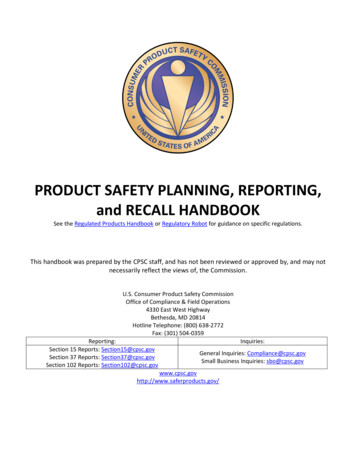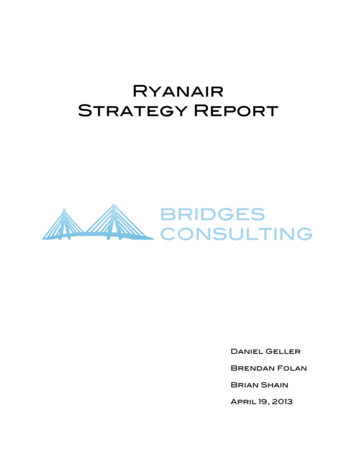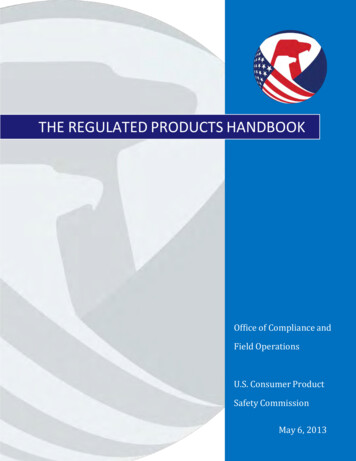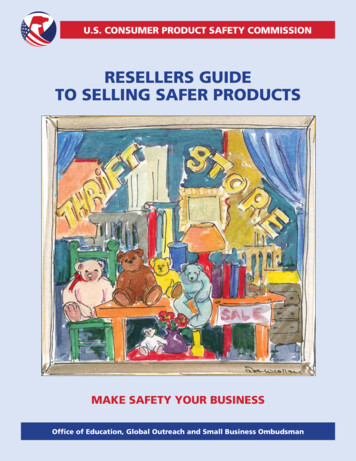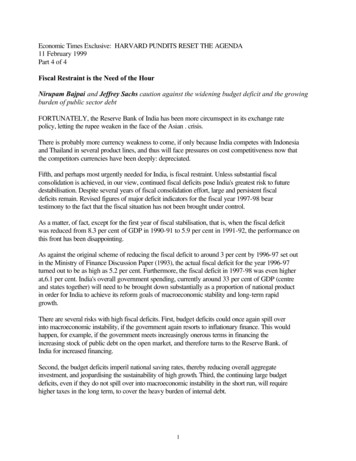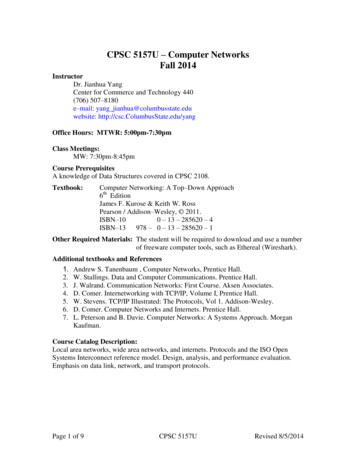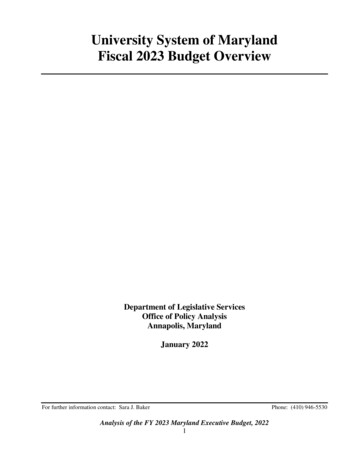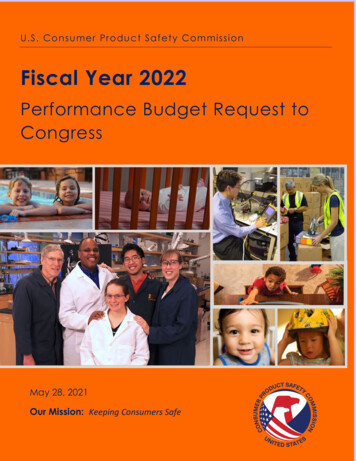
Transcription
U.S . ConsumerConsumer Product Safety Commission4330 East West HighwayProductSafety Commis si onBethesda, MD 20814Fiscal Year 2022Performance Budget Request toCongressMay 28, 2021Our Mission: Keeping Consumers Safe
About the Consumer Product Safety Commission (CPSC)The CPSC is an independent federal regulatoryagency with a public health and safety mission toprotect the public from unreasonable risks of injuryand death from consumer products.The Commission consists of five members appointedby the President with the advice and consent of theSenate. The Chairman is the head of the Commissionand principal executive officer of the CPSC.The Consumer Product Safety Act (CPSA) createdthe CPSC in 1972. In addition to the CPSA, asamended by the Consumer Product SafetyImprovement Act of 2008 (CPSIA), and Pub. L. No.112-28, the CPSC administers the Federal HazardousSubstances Act, the Flammable Fabrics Act, thePoison Prevention Packaging Act, the RefrigeratorSafety Act, the Virginia Graeme Baker Pool and SpaSafety Act, the Children’s Gasoline Burn PreventionAct, the Labeling of Hazardous Art Materials Act, theDrywall Safety Act of 2012, and the Child NicotinePoisoning Prevention Act.The CPSC has jurisdiction over thousands of types of consumer products used in and around the home, inrecreation, and in schools, from children’s toys to portable gas generators and toasters. Although ourregulatory purview is quite broad, a number of product categories fall outside the CPSC’s jurisdiction. 1The CPSC accomplishes its mission to protect consumers against the unreasonable risk of injury and deathassociated with consumer products by using analysis, regulatory policy, compliance and enforcement, andeducation to identify and address product safety hazards. This important work includes: Hazard Identification and Assessment—collecting information and developing injury and death statisticsregarding the use of products under the CPSC’s jurisdiction;Voluntary Standards 2 and Mandatory Regulations 3—participating in the development and strengtheningof voluntary standards and developing mandatory regulations;Import Surveillance—using a Risk Assessment Methodology (RAM) to analyze import data to identify andinterdict violative consumer products before they enter commerce in the United States;Compliance and Enforcement—enforcing compliance with mandatory regulations and removingdefective products through compliance activities, such as recalls or other corrective actions, and litigating,when necessary;Public Outreach—educating consumers, families, industry, and state, local, and foreign governmentsabout safety programs, alerts and recalls, emerging hazards, mandatory regulations, voluntary standards,and product safety requirements in the United States;Intergovernmental Coordination—coordinating work on product safety issues with other federalgovernment stakeholders; andCooperation with Foreign Governments—leveraging work with foreign government safety agencies,bilaterally and multilaterally, to improve safety for U.S. consumers.1Different federal agencies regulate other product categories, such as automobiles; boats; alcohol, tobacco, and firearms; foods, drugs, cosmetics, andmedical devices; and pesticides.2A “voluntary standard” is a consensus product standard and/or safety standard. See: Standards for a description of CPSC Voluntary standards activities.3A “mandatory regulation” is a mandatory standard and called a technical regulation.
Table of ContentsBudget DiscussionSummary of ChangesFY 2022 Budget Adjustments . . . . . . . . . . . . . . . . . . . . . . . . . . . . . . . . . . . . . . . . . . . . . . . . . . . . . . . . . . . . . . . . . . . . . . . . . . . . . . . . . . . . . . . . . . . . . . . . . . . . . . . . . . . . . . . . . . . . . . . . . . . . . . . . . . . . . . . . . . . . . . . . . . . . 1Table 1 – Summary of Changes from the FY 2021 Request . . . . . . . . . . . . . . . . . . . . . . . . . . . . . . . . . . . . . . . . . . . . . . . . . . . . . . . . . . . . . . . . . . . . . . . . . . . . . . . . . . . . . . . . . . 1Proposed Appropriations Language . . . . . . . . . . . . . . . . . . . . . . . . . . . . . . . . . . . . . . . . . . . . . . . . . . . . . . . . . . . . . . . . . . . . . . . . . . . . . . . . . . . . . . . . . . . . . . . . . . . . . . . . . . . . . . . . . . . . . . . . . . . . . . . . . . . . . . 6Executive SummaryBudget Priorities . . . . . . . . . . . . . . . . . . . . . . . . . . . . . . . . . . . . . . . . . . . . . . . . . . . . . . . . . . . . . . . . . . . . . . . . . . . . . . . . . . . . . . . . . . . . . . . . . . . . . . . . . . . . . . . . . . . . . . . . . . . . . . . . . . . . . . . . . . . . . . . . . . . . . . . . . . . . . . . . . . . . . . . . . . . . . . 7Budget Discussion by Strategic GoalStrategic Plan . . . . . . . . . . . . . . . . . . . . . . . . . . . . . . . . . . . . . . . . . . . . . . . . . . . . . . . . . . . . . . . . . . . . . . . . . . . . . . . . . . . . . . . . . . . . . . . . . . . . . . . . . . . . . . . . . . . . . . . . . . . . . . . . . . . . . . . . . . . . . . . . . . . . . . . . . . . . . . . . . . . . . . . . . . . . . . . . . . . . 9Table 2 – FY 2022 Request by Strategic Goal and Program Component . . . . . . . . . . . . . . . . . . . . . . . . . . . . . . . . . . . . . . . . . . . . . . . . . . . . . . . . . . . . . . . . 9Strategic Goal 1 . . . . . . . . . . . . . . . . . . . . . . . . . . . . . . . . . . . . . . . . . . . . . . . . . . . . . . . . . . . . . . . . . . . . . . . . . . . . . . . . . . . . . . . . . . . . . . . . . . . . . . . . . . . . . . . . . . . . . . . . . . . . . . . . . . . . . . . . . . . . . . . . . . . . . . . . . . . . . . . . . . . . . . . . . . . . . . 10Strategic Goal 2 . . . . . . . . . . . . . . . . . . . . . . . . . . . . . . . . . . . . . . . . . . . . . . . . . . . . . . . . . . . . . . . . . . . . . . . . . . . . . . . . . . . . . . . . . . . . . . . . . . . . . . . . . . . . . . . . . . . . . . . . . . . . . . . . . . . . . . . . . . . . . . . . . . . . . . . . . . . . . . . . . . . . . . . . . . . . . . 12Strategic Goal 3 . . . . . . . . . . . . . . . . . . . . . . . . . . . . . . . . . . . . . . . . . . . . . . . . . . . . . . . . . . . . . . . . . . . . . . . . . . . . . . . . . . . . . . . . . . . . . . . . . . . . . . . . . . . . . . . . . . . . . . . . . . . . . . . . . . . . . . . . . . . . . . . . . . . . . . . . . . . . . . . . . . . . . . . . . . . . . . 16Strategic Goal 4 . . . . . . . . . . . . . . . . . . . . . . . . . . . . . . . . . . . . . . . . . . . . . . . . . . . . . . . . . . . . . . . . . . . . . . . . . . . . . . . . . . . . . . . . . . . . . . . . . . . . . . . . . . . . . . . . . . . . . . . . . . . . . . . . . . . . . . . . . . . . . . . . . . . . . . . . . . . . . . . . . . . . . . . . . . . . . . 18Strategic Crosscutting Priorities. . . . . . . . . . . . . . . . . . . . . . . . . . . . . . . . . . . . . . . . . . . . . . . . . . . . . . . . . . . . . . . . . . . . . . . . . . . . . . . . . . . . . . . . . . . . . . . . . . . . . . . . . . . . . . . . . . . . . . . . . . . . . . . . . . . . . . . . . . . . . . . . . . . 2 1Standards and RulemakingsVoluntary Standards Summary . . . . . . . . . . . . . . . . . . . . . . . . . . . . . . . . . . . . . . . . . . . . . . . . . . . . . . . . . . . . . . . . . . . . . . . . . . . . . . . . . . . . . . . . . . . . . . . . . . . . . . . . . . . . . . . . . . . . . . . . . . . . . . . . . . . . . . . . . . . . . . . . . . . . . . 2 3Mandatory Standards Summary . . . . . . . . . . . . . . . . . . . . . . . . . . . . . . . . . . . . . . . . . . . . . . . . . . . . . . . . . . . . . . . . . . . . . . . . . . . . . . . . . . . . . . . . . . . . . . . . . . . . . . . . . . . . . . . . . . . . . . . . . . . . . . . . . . . . . . . . . . . . . . . . . . . 2 6Annual Performance Plan2018–2022 Strategic Plan Summary . . . . . . . . . . . . . . . . . . . . . . . . . . . . . . . . . . . . . . . . . . . . . . . . . . . . . . . . . . . . . . . . . . . . . . . . . . . . . . . . . . . . . . . . . . . . . . . . . . . . . . . . . . . . . . . . . . . . . . . . . . . . . . . . . . . . . . . . . . . . 2 9Key Performance Measure Summary . . . . . . . . . . . . . . . . . . . . . . . . . . . . . . . . . . . . . . . . . . . . . . . . . . . . . . . . . . . . . . . . . . . . . . . . . . . . . . . . . . . . . . . . . . . . . . . . . . . . . . . . . . . . . . . . . . . . . . . . . . . . . . . . . . . . . . . . . . 3 0Annual Performance Plan Details . . . . . . . . . . . . . . . . . . . . . . . . . . . . . . . . . . . . . . . . . . . . . . . . . . . . . . . . . . . . . . . . . . . . . . . . . . . . . . . . . . . . . . . . . . . . . . . . . . . . . . . . . . . . . . . . . . . . . . . . . . . . . . . . . . . . . . . . . . . . . . . . . 3 2AppendicesAppendix A – Unfunded Priorities.42Appendix B – Technical Budget TablesTable 3 – Program and Financing Schedule . . . . . . . . . . . . . . . . . . . . . . . . . . . . . . . . . . . . . . . . . . . . . . . . . . . . . . . . . . . . . . . . . . . . . . . . . . . . . . . . . . . . . . . . . . . . . . . . . . . . . . . . . . . . . . . . . . . . . . . 46Table 4 – Object Classification Schedule and Personnel Summary . . . . . . . . . . . . . . . . . . . . . . . . . . . . . . . . . . . . . . . . . . . . . . . . . . . . . . . . . . . . . . . . . . . . . . . . . . 47Table 5 – CPSC FTEs by Organization . . . . . . . . . . . . . . . . . . . . . . . . . . . . . . . . . . . . . . . . . . . . . . . . . . . . . . . . . . . . . . . . . . . . . . . . . . . . . . . . . . . . . . . . . . . . . . . . . . . . . . . . . . . . . . . . . . . . . . . . . . . . . . . . . . . 48Table 6 – Inspector General Budget Request . . . . . . . . . . . . . . . . . . . . . . . . . . . . . . . . . . . . . . . . . . . . . . . . . . . . . . . . . . . . . . . . . . . . . . . . . . . . . . . . . . . . . . . . . . . . . . . . . . . . . . . . . . . . . . . . . . . . 49Appendix C – Acronyms . . . . . . . . . . . . . . . . . . . . . . . . . . . . . . . . . . . . . . . . . . . . . . . . . . . . . . . . . . . . . . . . . . . . . . . . . . . . . . . . . . . . . . . . . . . . . . . . . . . . . . . . . . . . . . . . . . . . . . . . . . . . . . . . . . . . . . . . . . . . . . . . . . . . . . . . . . . . . . . . . . . . . 50Appendix D – Organizational Structure . . . . . . . . . . . . . . . . . . . . . . . . . . . . . . . . . . . . . . . . . . . . . . . . . . . . . . . . . . . . . . . . . . . . . . . . . . . . . . . . . . . . . . . . . . . . . . . . . . . . . . . . . . . . . . . . . . . . . . . . . . . . . . . . . . . . . . . 51
This page is intentionally left blank.
2022 Performance Budget Request to CongressBudget DiscussionSummary of ChangesFY 2022 Budget AdjustmentsMaintain Current Levels Pay ( 3.3 million): The CPSC requests anadditional 3.3 million for personnel salary andbenefits for 539 full-time equivalents (FTEs),consistent with the staffing level supported in theFY 2021 annual appropriation. 4 This Request willcover the 2.7% pay raise directed by the Office ofManagement and Budget (OMB) and other payrollcosts, such as within-grade increases, earnedpromotions, and locality pay adjustments.Non-Pay ( 1.2 million): The CPSC requests anadditional 1.2 million for non-pay inflation itemsto maintain current levels. The CPSC applied astandard inflation rate of 2% for existing recurringcontracts and agreements, plus known escalationamounts for collecting hospital emergencydepartment data, and increased lease costs.Changes to Program Table 1: Summary of Changes from the FY 2021 Request(Dollars in millions)DollarsFY 2021 Enacted 135.0Maintain Current Levels: Pay 3.3 Non-Pay 1.2Changes to Program: Support Robust Import Surveillanceand Targeting Expand Hazard IdentificationCapability Expand Vigorous Compliance ThroughIncreased Internet Surveillance 8.3 16.1 1.5 Enhance Communications 1.6 Bolster Agency Operational Support 4.1 Inspector General Support 0.2 VGB Grants- 1.3Support Robust Import Surveillance and TargetingProposed FY 2022 CPSC Budget 170.0( 8.3 million): The CPSC requests an additional 8.3 million and 38 FTEs for implementingrequirements related to the CPSC import surveillance program set forth in the Consolidated AppropriationsAct, 2021 (Pub. L. No. 116-260), Division FF, Title XX, and for enhancing targeting, surveillance, andscreening of consumer products. The additional request funds efforts in the following areas:1.Expand eCommerce Presence ( 1.9 million): CPSC is requesting funding for 10 FTEs in FY 2022 forthe eCommerce Team. With the rapid growth of the digital marketplace, there has been asignificant global shift from the traditional consumer product distribution chain (e.g., retail stores)to online shopping, resulting in a large volume of low-value, potentially violative or hazardousshipments of foreign-manufactured products being shipped directly to consumers in the UnitedStates. Enforcement of the sale and distribution of goods on eCommerce platforms is one of thebiggest challenges facing the agency. In FY 2021, the newly established eCommerce Team is slatedto establish a physical presence at a location with a high volume of de minimis 5 shipments,supported by the American Rescue Plan Act of 2021 (ARPA) to fund 4 FTEs for this effort. We arerequesting funding for an additional 6 FTEs to support expansion of the eCommerce Team in FY2022. Moreover, because ARPA funds are time-limited, we are requesting that the 4 FTEs fundedin FY 2021 through ARPA be included in this FY 2022 budget request, for a total of 10 FTEs.4The staffing level of the FY 2021 enacted appropriations does not include the 28 FTEs and recurring costs that were funded in FY 2021 by the ARPA(Pub. L. No. 117-2) appropriation. These FTEs and recurring costs for FY 2022 are included as a part of this Request of the CPSC’s annual salariesand expenses appropriation. Shifting those costs would establish a budgetary baseline for these costs to be sustained over time and also allow more ofthe ARPA funds to be available for the agency to invest in one-time technology and other contract costs related to eCommerce and other ARPArequirements.5De minimis shipments are low-value, direct-to-buyer shipments valued at 800 or less. Because de minimis shipments may enter the United Stateswith minimal data requirements, the risk associated with these shipments is largely unknown.May 2021Page 1
2022 Performance Budget Request to Congress2.Budget DiscussionExpand Traditional Ports ( 1.1 million): The agency requests 6 FTEs for FY 2022 to supportstaffing at four additional ports of entry where CPSC previously had no presence, and where thelevel of import activity creates the highest-risk environment for potentially violative products.Funding for these 6 FTEs is currently supported through ARPA, but because those funds expire inFY 2026, CPSC seeks to fund the six positions through the annual appropriation request to increasethe long-term viability of port staffing levels.3.Lab and Compliance Support ( 2.6 million): The addition of port investigators at traditional portsand the establishment of an eCommerce team create the need for supplementary resources tosupport the increase in shipments sampled. Each sample requires technical staff to analyze and/ortest the sample for compliance. For samples found to be violative, CPSC staff works withcompanies to implement appropriate corrective actions or pursues enforcement actions wherecooperative resolution does not occur. To address the expected increase in sample testing andenforcement resulting from CPSC’s expansion in port surveillance at traditional ports, as well as theestablishment of a new eCommerce Team, CPSC is requesting 14 FTEs, of which 7 FTEs are for labsupport and 7 FTEs are for compliance and enforcement efforts. The ARPA funded 6 FTEs in FY2021 of the requested 14 FTEs for FY 2022. As with the request for port and eCommerce staffcurrently funded through ARPA, the agency seeks to include funding for those 6 FTEs in thisbudget request.4.Enhance Targeting, Surveillance, and Screening Systems ( 1.6 million): Significant investment intechnology is required to enhance CPSC’s Risk Assessment Methodology (RAM) system, expand itscapabilities related to eFiling and de minimis shipments, and explore possibilities for identificationof defective products. The agency is in the early stages of the development of the Global DataSynchronization Network (GDSN) integration into the CPSC’s RAM system. This is the first part ofthe full implementation of the Global Trade Item Number (GTIN) project that is foundational forestablishing an eFiling program. This effort is designed to provide linkage to products via GTIN barcode at the time of importation, a process that will, in turn, support and enhance risk research.Using ARPA funds, the CPSC will fund a contract to define and execute the architecture forintegrating GTIN data into the agency’s database for usage in various applications, including thosethat support RAM and eFiling. However, to fully implement the proposed enhancements, theagency will require additional resources to create and fund an eFiling program, conduct an eFilingBeta Pilot, and initiate rulemaking. This budget request will support development of those efforts.In addition, to ensure sound management of the eFiling effort from its inception, CPSC requests 2FTEs to oversee implementation of the eFiling project, which includes technology investments andrulemaking development. One of the 2 FTEs was funded with ARPA funds in FY 2021, and we seekto include funding for that FTE in this budget request.5.May 2021Operational Support ( 1.1 million): The CPSC requests an additional 6 FTEs for operationalsupport. The ARPA funded 4 FTEs in FY 2021 to support expanded port and eCommerce activity,and CPSC needs an additional 2 FTEs in FY 2022 to support planned continued expansion. Thesestaffing resources are required to provide the necessary infrastructure support for the expansion oftraditional port coverage, creation of a new eCommerce Team, and increase testing andenforcement. CPSC will be recruiting, onboarding, and training the expanded staff; providingfinancial management support, including cost analysis and accounting to manage the separateappropriations; supporting the increased technology demands from CPSC’s increase in importtargeting and enforcement; and providing increased legal support associated with the uptick incases and coordinating with the Department of Justice (DOJ) on enforcement matters. Four of the6 FTEs were funded with ARPA funds in FY 2021, and we seek to include funding for those 4 FTEsin this budget request.Page 2
2022 Performance Budget Request to Congress Budget DiscussionExpand Hazard Identification Capability ( 16.1 million): CPSC requests an additional 16.1 million and 8FTEs for critical research and analysis of hazardous consumer products. The additional request funds effortsin the following areas:1.Augmenting Applied Research ( 6.5 million): The agency requests additional funding to closeidentified shortfalls in applied research within hazard identification. Applied research is a centralelement of the agency’s approach to protecting consumers from unreasonable risks of harm, andit supports many of CPSC’s voluntary and mandatory standards efforts and other safety initiatives.Specific priority research funded by this Request includes: investigation of hazards associated withadditive manufacturing (e.g., 3-D printing); analysis on the impact of smart technologies andInternet connectivity on product safety; research on home fire hazard mitigation, including flamesuppression and flame jetting; and senior safety.The 6.5 million also includes funding to conduct research to identify safe sleep parameters for allinfant sleep products. According to CPSC’s 2020 Nursery Product Annual Report, the agencyreceived reports of 357 deaths related to nursery products from 2015 through 2017, with infantsleep products being associated with the most deaths (nearly 70 percent or 249 of 357 deaths).Additionally, this research would provide baseline information pertaining to the infant sleepenvironment, enabling the evaluation of potential new sleep products and safety standards. Withthe current limited data on infant sleep hazards, sleep product standards are developed largely bybenchmarking from existing safety standards. This approach limits product innovation and createssignificant safety uncertainties. The research will evaluate traditional infant sleep environment,sleep product characteristics, and characteristics of other infant products in which infants sleep.Mortality data will be reviewed and analyzed to evaluate product involvement and proposerecommendations for voluntary standards revisions or development.2.Focus on Chronic Hazards ( 4.5 million): The CPSC’s request for an additional 4.5 million willposition the agency to have a more effective and meaningful role in addressing chronic hazardsassociated with exposures to classes of toxic chemicals in toys, art supplies, kitchenware,playgrounds, clothing, furniture, household cleaners, and other consumer products. Assessingchronic hazards in consumer products to protect the public is not an easy task and requiresvoluminous amounts of information and research to determine not only toxicity, but also risk andexposure. CPSC’s work on organohalogen flame retardants (OFRs), playground crumb rubber, andindoor air quality are examples of issues that present chronic hazards that CPSC will address withthese resources.3.Invest Significantly in Artificial Intelligence (AI) ( 3.5 million): The agency requests an additional 3.5 million to enhance its enterprise analytic capabilities with a cloud-based, machine-learningcapable software. Investments in this artificial intelligence capability will enable the agency tomake significant strides in data analysis that cannot be achieved through the agency’s currentminimally funded, ad hoc approach. This request is in line with the agency’s next-generationEnterprise Data Analytics Strategy for consumer product safety.4.May 2021Enhance Data Collection ( 1.6M): The agency requests an additional 1.6 million and 8 FTEs toimprove CPSC’s data collection and analysis of product safety incidents, injuries, and deaths,including data that reflect potential safety disparities. The ARPA funded 3 of the 8 FTEs in FY 2021,and the agency requests an additional 5 FTEs for FY 2022. The additional staffing resources wouldsupport the agency’s data collection and analysis capabilities, with a focus on consumer productsafety risks resulting from the COVID-19 pandemic affecting socially disadvantaged individuals andother vulnerable populations. The new FTEs would also recruit, train, and collect data from the 20Page 3
2022 Performance Budget Request to CongressBudget Discussionto 30 hospitals to be added to CPSC’s National Electronic Injury Surveillance System (NEISS). 6 CPSCwill leverage its enterprise analytics platform and the NEISS to support increased data analysis thatis essential to protecting American consumers. Three of the 8 FTEs were funded with ARPA fundsin FY 2021, and we seek to include funding for those 3 FTEs in this budget request. Expand Vigorous Compliance Through Increased Internet Surveillance ( 1.5 million): eCommerce hasevolved from an emerging issue to one that has become central to the way American consumers andsellers interact. This growing eCommerce footprint requires a corresponding increase in Internetsurveillance to identify and remove violative products being offered for sale online, including counterfeitproducts that present a safety issue. Because it is critical that the agency increase its Internet surveillanceefforts to address the burgeoning online marketplace, we are seeking to add 8 FTEs. These staffingresources include 5 FTEs (compliance officers and product safety investigators for the Internet SurveillanceUnit) and 3 FTEs (lab and compliance support). This effort will complement work at the traditional ports andwill also serve as a strong signal of how seriously the agency is taking eCommerce issues. Two of the 8 FTEswere funded with ARPA funds in FY 2021, and we seek to include funding for those 2 FTEs in this budgetrequest.Enhance Communications ( 1.6 million): The agency requests an additional 1.6 million to enhancecommunications efforts alerting consumers, especially those who are disadvantaged and underserved, tothe dangers of portable fuel containers, carbon monoxide (CO) poisoning, portable generators, and otherhigh-risk consumer products. Additionally, CPSC will continue developing significant communicationsefforts to address COVID-19 product-related risks and expand the development, dissemination, andeffectiveness of other consumer product safety information, as directed in the ARPA. Communicationsefforts will include targeted campaigns on issues highlighted in CPSC staff’s recent report, “Effect of NovelCoronavirus Pandemic on Preliminary NEISS Estimates (March–September, 2020),” beginning withcampaigns on batteries, fireworks, and senior safety. An additional 4 FTEs will assist with creating,coordinating, and deploying content for community outreach, youth outreach, education campaigns, andsocial media campaigns. Contract dollars will fund new or supplemental contracts with outsidecommunications firms that can provide campaign support (including content design, development ofcampaign messaging, and production of digital/print safety materials), as well as covering staff costs forprojects. Two of the 4 FTEs were funded with ARPA funds in FY 2021, and we seek to include funding forthose 2 FTEs in this budget request.Bolster Agency Operational Support ( 4.1 million)1.2.Technology ( 2.1 million): A substantial commitment to information technology (IT)development and modernization will allow the agency to keep pace with continuing advances intechnology to improve the ability of the agency to work more efficiently and effectively. Thisincrease to baseline funding will support a multiyear effort to incrementally modernize existing ITinfrastructure and provide sufficient funds to bolster and support mission-facing IT systems.Recruitment Initiatives ( 1.5 million): The agency requests an additional 1.5 million in fundingfor initiatives to enhance and support recruitment efforts necessary to reduce skills gaps in newemerging technologies expertise and mission-support areas. These efforts also will entailproactive measures that seek to foster inclusion, equity, and diversity in the CPSC’s workforce. Toaddress the agency’s staffing needs and to attract and maintain qualified staff, the CPSC mustidentify candidates with specialized expertise sought after by the agency and use permitted6The NEISS uses a stratified sample of hospitals nationwide to enable probabilistic national estimates of consumer product-related injuries. Thisenables the CPSC and others to identify patterns and trends in these injuries, informing a wide range of voluntary standards, mandatory standards,information and education campaigns, and other initiatives. The sample of NEISS was last selected in 1997. In FY 2020, in consultation with OMB, theCPSC contracted a review of the NEISS sample. To implement the anticipated findings of that review, the CPSC will require recruitment, training, andparallel data collection of 20 to 30 additional hospitals to the NEISS system to enable valid comparisons between data prior to the sample change andafterward.May 2021Page 4
2022 Performance Budget Request to CongressBudget Discussioncompetitive salaries, professional development, and other incentives to recruit and hire talented,diverse candidates. In addition to competitive incentives, CPSC’s Office of Human ResourcesManagement and hiring officials will need advanced training on this specialized recruitmentinitiative to ensure the agency is fulfilling its Workforce Strategic Goal.3. Records Efficiency and Transparency Initiative ( 0.5 million): The agency requests an additional 0.5 million for its Freedom of Information Act (FOIA) and records management programs. Theseadditional resources will allow the agency to enhance its ability to comply in a timely and effectivemanner with all applicable laws and regulations.Inspector General Support ( 0.2 million): The CPSC requests an additional 0.2 million and 1 FTE for theOffice of the Inspector General (OIG). These additional resources will aid the OIG in providing oversightcommensurate with the CPSC’s increased funding level for FY 2022.Virginia Graeme Baker Pool and Spa Safety Act (VGB Act) Grants (- 1.3 million): The CPSC will continue toaward VGB Act grants using the available no-year appropriation balances provided in the FY 2021 and priorenacted appropriation and will communicate if additional funding is required in future budgets.May 2021Page 5
2022 Performance Budget Request to CongressBudget DiscussionProposed Appropriations LanguageU.S. Consumer Product Safety CommissionSalaries and ExpensesFor necessary expenses of the U.S. Consumer Product Safety Commission, including hireof passenger motor vehicles, services as authorized by 5 U.S.C. 3109, but at rates forindividuals not to exceed the per diem rate equivalent to the maximum rate payableunder 5 U.S.C. 5376, purchase of nominal awards to recognize non-federal officials’contributions to Commission activities, and not to exceed 4,000 for official reception andrepresentation expenses, 170,000,000.May 2021Page 6
2022 Performance Budget Request to CongressBudget DiscussionExecutive SummaryCPSC Budget PrioritiesThe U.S. Consumer Product Safety
consistent with the staffing level supported in the FY 2021 annual appropriation.4 This Request will cover the 2.7% pay raise directed by the Office of Management and Budget (OMB) and other payroll costs, such as within-grade increases, earned promotions, and locality pay adjustments. Non-Pay ( 1.2 million): The CPSC requests an

